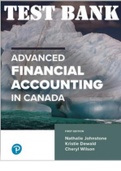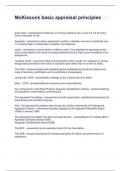1 Copyright © 2023 Pearson Canada Inc. Advanced Accounting in Canada, 1Ce (Johnstone) Chapter 1 Introduction to Advanced Financial Accounting 1.1 Describe the accounting standards used in Canada and how they apply to different reporting entities. 1) A private company in Canada that is closely held, has no debt, and wants to simplify the accounting process is most likely to report under which part of the CPA Canada Handbook? A) Part II — Accounting Standards for Private Enterprises (ASPE) B) Part IV — Accounting Standards for Pensions C) Part I — International Financial Reporting Standards (IFRS) D) Part III — Accounting Standards for Not-for-Profit Organizations Answer: A Diff: 1 Type: MC Taxonomy Category: Understanding Learning Outcome: 1.1 Describe the accounting standards used in Canada and how they apply to different reporting entities. 2) In Canada, a private company has the choice to report under International Financial Reporting Standards (IFRS) or Accounting Standards for Private Enterprises (ASPE). Describe why the CPA Canada Handbook provides the option for private enterprises? Answer: IFRS is meant to create consistency and comparability in international markets. One of the limitations of IFRS is the complexity of reporting for equity investments that are meant to provide information to shareholders for decision-making purposes. Many private companies are held by a small group of shareholders who are often involved in the running of the business or have access to that information. As a result, the cost of applying more complex accounting policies outweighs the benefit of the information provided to this closely held group of shareholders. To address this, the Accounting Standards Board developed the Accounting Standards for Private Enterprises to meet the needs of private enterprises. Private enterprises have the option to adopt IFRS or ASPE depending on the needs of the financial statement users. Diff: 2 Type: ES Taxonomy Category: Understanding Learning Outcome: 1.1 Describe the accounting standards used in Canada and how they apply to different reporting entities. 3) What are the four parts of the CPA Canada Handbook — Accounting and which entities are they applicable to? Answer: The four parts are: • Part I — International Financial Reporting Standards (IFRS) — applicable to publicly accountable, private, or not-for-profit entities. • Part II — Accounting Standards for Private Enterprises (ASPE) — applicable to private entities. • Part III — Accounting Standards for Not-for-Profit Organizations — applicable to not-for-profit entities. • Part IV — Accounting Standards for Pension Plans — applicable to pension plans. Diff: 1 Type: ES Taxonomy Category: Remembering Learning Outcome: 1.1 Describe the accounting standards used in Canada and how they apply to different reporting entities. 2 Copyright © 2023 Pearson Canada Inc. 1.2 Discuss the conceptual framework for financial reporting and the general purpose of financial reporting. 1) In 2011, Canada adopted International Financial Reporting Standards (IFRS) for publicly accountable enterprises. Explain the rationale for adopting IFRS in Canada. Answer: As the global economy expanded, the Accounting Standards Board (AcSB) chose to adopt IFRS in Canada to improve consistency and comparability in the international capital markets. Diff: 1 Type: ES Taxonomy Category: Understanding Learning Outcome: 1.2 Discuss the conceptual framework for financial reporting and the general purpose of financial reporting. 1.3 Define and identify strategic and non-strategic intercorporate investments made by reporting entities. 1) Laliberte Products Ltd. (LPL), a public company, made several equity investments in the current year. Which of the following investments would most likely be classified as an associate in LPL's financial statements? A) 25,000 of the 30,000 outstanding voting common shares of Glabman Inc. There are significant intercompany transactions between the two companies. B) 13,500 of the 45,000 outstanding voting common shares of CCL Ltd. There are significant intercompany transactions between the two companies. C) 1,000 of the 20,000 outstanding voting common shares of Petruck Inc. There are no transactions between the two corporations and LPL plans to hold these shares for less than a year. D) 3,000 of the 3,500 outstanding non-voting preferred shares of Paradise Ltd. There is a small number of intercompany transactions between the two companies. Answer: B Diff: 2 Type: MC Taxonomy Category: Analyzing Learning Outcome: 1.3 Define and identify strategic and non-strategic intercorporate investments made by reporting entities. 2) What is the definition of control provided in IFRS 10? Answer: IFRS 10 states that an investee has control only when all of the following three criteria are met: The power over the investee, exposure to the variable returns of the investee, and the ability to use that power to affect the earnings of the investee. First, the power to direct the relevant activities over the investee typically arises from a right such as voting rights, the right to choose key personnel or enforcement/veto rights. Power over the relevant activities would include the ability to direct the selling or buying of goods and services, direct research and development, budgeting, and the management of financial assets. Second, variable returns are defined as not fixed and with the potential to vary as a result of the performance of the investee. Finally, there must be a link between the power to control the relevant activities and the return on the investment. Diff: 2 Type: ES Taxonomy Category: Understanding Learning Outcome: 1.3 Define and identify strategic and non-strategic intercorporate investments made by reporting entities. 3 Copyright © 2023 Pearson Canada Inc. 3) List the four different classifications of investments and provide a definition for each type of investment classification. Answer: The four classifications along with a definition are given below: 1. Passive Investment is an equity investment that does not meet the definition of an associate (significant influence under ASPE), joint arrangement, or subsidiary. These investments tend to be more short term and temporary in nature. These can be classified as fair value through other comprehensive income, fair value through profit and loss, and in some rare cases, cost. 2. Associate (Significant Influence under ASPE) is an equity investment where the investor has the ability to influence the activities of the investee but does not have control. 3. Joint Arrangement is a contractual agreement where the parties have joint control over the investment. These can be classified as either joint ventures or joint operations. 4. Subsidiary is an equity investment where the investor has the ability to control the activities of the investee. Diff: 2 Type: ES Taxonomy Category: Understanding Learning Outcome: 1.3 Define and identify strategic and non-strategic intercorporate investments made by reporting entities. 4) What is a financial asset, and would a non-strategic equity investment be included in that definition? Answer: A financial asset, as defined in IAS 32, is any of the following: • Cash • An equity investment in another company • A contractual right to receive cash or another asset from another company • A contractual right to exchange another financial instrument under potentially favourable conditions Investments in equities are listed in the definition of a financial asset; therefore, a non-strategic equity investment would meet the definition. Diff: 2 Type: ES Taxonomy Category: Understanding Learning Outcome: 1.3 Define and identify strategic and non-strategic intercorporate investments made by reporting entities.





